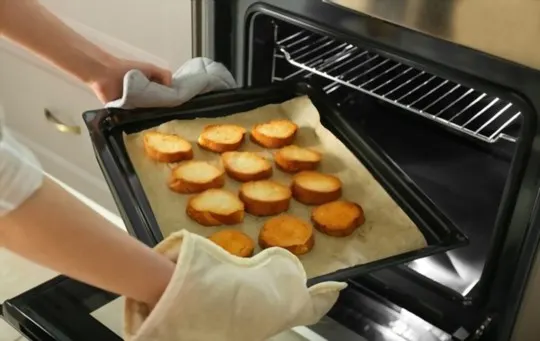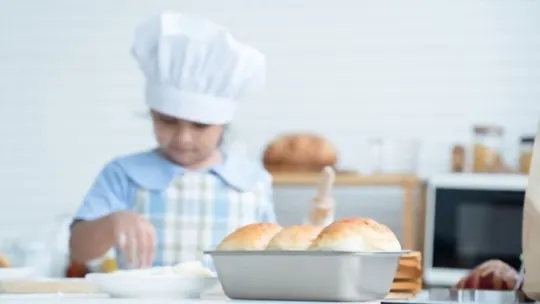Are you stuck in a baking rut, searching for a Loaf Pan substitute? Look no further.
In this article, you’ll discover the 5 best alternatives to help you make the most delicious treats.
Unlock your creative culinary potential with these top-notch substitutes and enjoy your home-made masterpiece.
What is Loaf Pan?

A loaf pan, or bread pan, is a type of baking pan used for making breads and cakes like quick breads and pound cakes.
Also referred to as a bread tin or cake tin, the typical loaf pan is rectangular in shape with sloped edges on two of the four sides.
This design allows for free-standing slices of the finished product to be removed easily from the pan while providing support on either side.
The traditional sides of most loaf pans are straight, allowing bakers to have more control over the shape of their finished product.
These straight sides also help provide an even rise throughout the entire loaf and prevents over-baked corners that sometimes occur with other types of pans.
Loaf pans can be made from a variety of materials including glass, ceramic, silicone and metal alloys such as aluminum, stainless steel and other metals that can withstand high temperatures.
Loaf pans are used in baking recipes where size matters — common uses include quick breads such as banana bread and zucchini bread; yeast-breads like white sandwich loaves; cakes like pound cakes; specialty cakes like angel food cake; and even meatloaves.
Using a loaf pan ensures that your recipes are baked with even heat throughout – no need to worry about over-baked or undercooked spots.
Keep in mind that different sizes will yield different outcome – mini loaves require shorter bake times than large ones – so follow your recipes accurately.
5 Best Loaf Pan Substitutes to Consider
Whether you’re out of bread pans or stuck in a pinch, don’t worry — there are several alternatives to traditional loaf pans that work just fine for baking bread.
Before choosing your substitution, it’s important to consider the size, shape and characteristics of the original pan you would have used.
For standard-sized bread recipes baking at 350 degree Fahrenheit (177 degree Celsius), here are five great substitutes for a loaf pan that every baker should keep in mind:
1 – Skillet

A skillet is a great substitute for a loaf pan when you want to make easy, one-pan meals.
The big advantage of using a skillet is that it can easily be transferred from the oven to the table or countertop.
This is especially handy if you’re making something like lasagna, where transferring the dish into a serving bowl may be difficult if done out of a traditional loaf pan.
Skillets are usually made of cast iron and come in circular, rectangular and square varieties.
Cast iron is known for its heat retention, which helps to evenly cook food and give it an even color throughout the cooking process.
The rounded corners also help distribute heat more evenly than square pans do.
Cleaning them can sometimes be tricky as cast iron has special instructions for maintenance; however, once you understand how to correctly clean and care for them, they are easy to use and maintain.
2 – Baking Sheet

A baking sheet is a flat rectangular metal pan used in an oven.
It is often referred to as a cookie sheet and is used predominantly for baking cookies, bread rolls and certain kinds of cakes.
Most baking sheets also have one or more raised edges to prevent items from sliding off the sheet while it’s being moved.
Baking sheets can also be used to roast vegetables and for free-form or no-bake desserts like frozen yogurt.
When using a baking sheet as a substitute for a loaf pan, it’s important to note that the food will not be contained in the same way as when using a loaf pan; it may slide off the edges of the baking sheet or get overly crispy on some sides due to air circulation.
To compensate for this issue, you can line your baking sheet with parchment paper or aluminum foil for easier clean-up and consistent cooking results.
When using an unlined baking sheet in lieu of a loaf pan, it’s important to use smaller amounts of ingredients than you normally would when using a traditional bread recipe, as larger loaves may spread too thinly on narrow cookie sheets.
3 – Cake Pan

A cake pan is a perfect substitute for a loaf pan.
Since it has sides that are either straight or slightly curved, it is suitable for baking everything from regular cakes to quick breads and loaves.
If you want your loaves of bread to have a crispy crust, go for the straight-sided variety of cake pans.
If you prefer the soft crusts traditional with banana and pumpkin breads, use cake pans with curved sides.
You’ll need to adjust the baking time and may want to reduce the oven temperature by 25°F so that your loaves don’t overcook on the exterior before the center is done.
It’s also a good idea to put a bit of water into any empty part of your oven during baking as this will help keep your finished loaf more moist.
4 – Casserole Dish

Replacing a loaf pan with a casserole dish is possible in some recipes and situations.
Again, the key is to ensure that the casserole dish is roughly the same volume as the loaf pan and consider whether a wider vs.
taller shape would work for your recipe.
If you decide to use a casserole dish, keep in mind that you may need to adjust the bake time since it offers greater surface area and less depth overall than a loaf pan does.
Furthermore, depending on what type of recipe you are making, you may need to choose between ceramic or glass for the temperature of your baking process.
Always follow baking time guidelines specific to your recipe’s material so that your finished product will come out as intended.
5 – Pie Plate

Pie plates and loaf pans are actually quite similar and can often be used interchangeably, so a pie plate could be a great substitute.
Pie plates are round and slightly shallower than a loaf pan, with straight sides and flat bottoms, although there are various sizes available.
When using a pie plate in place of a loaf pan, it’s best to use one that’s close in size to the pan it replaces — for example, if you need an 8 inch loaf pan, use an 8-9 inch pie plate.
For cupcakes or muffins, you may want to use individual cupcake tins or muffin tins, as pie plates are not designed for these shapes.
However, for larger cakes such as pound cakes or fruit cobblers it can work just as well.
Keep in mind that since the sides of the pie plate aren’t as high as those of the loaf pans you may have an easier time removing your cake from the dish if you line it with parchment paper or use non-stick spray prior to baking your batter.
Conclusion
Loaf pans have been a kitchen essential since the time of our ancestors.
They are essential for making cakes, breads and meatloaves.
Although they are widely available, there may be times when you don’t have one or cannot find a suitable size.
If this happens, it’s important to know that there are several excellent substitutes you can use.
The key to success is selecting the appropriate shape and size according to what you intend to bake in the oven.
If unsure about which substitute would work best for you, it’s always recommended that you consult a cookbook or two for more precise measurements that suit your recipe’s needs.

5 Best Loaf Pan Substitutes to Consider
Ingredients
- 1 – Skillet
- 2 – Baking Sheet
- 3 – Cake Pan
- 4 – Casserole Dish
- 5 – Pie Plate
Instructions
- Choose your preferred substitute from the list of options.
- Organize all of your ingredients.
- Use the proper substitute to cook your recipes.

Carrie is a food writer and editor with more than 15 years of experience. She has worked for some of the biggest names in the food industry, including Bon Appétit, Food & Wine, and Martha Stewart Living.
As the Editor in Chief of IntroChicago.com, Carrie oversees all of the content on the site. She also manages the team of contributing writers and editors, who help to create delicious recipes, helpful tips, and informative articles that you’ll find on the site.
A native of the Chicago area, Carrie is passionate about all things food. She loves trying new restaurants and experimenting with new recipes in her kitchen. She’s also a graduate of the Culinary Institute of America, so she knows a thing or two about food!
